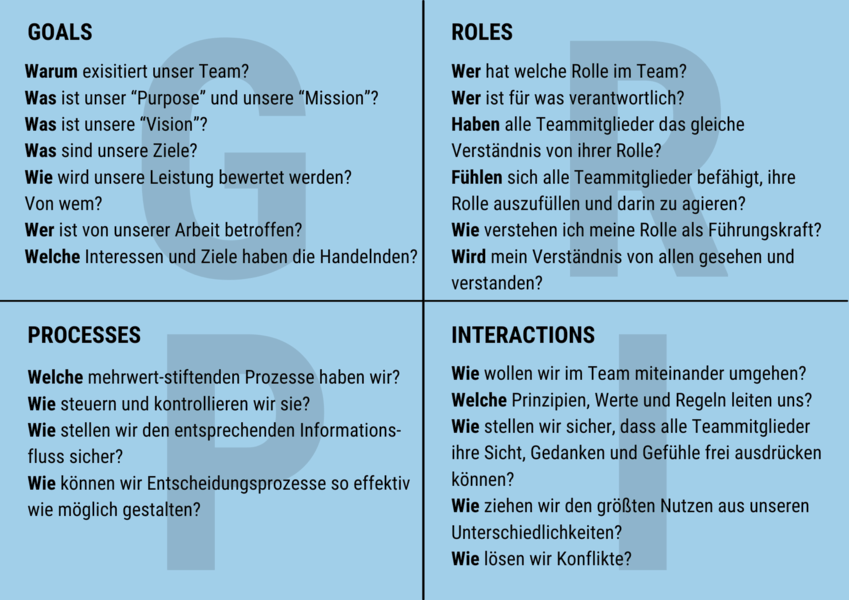Created by Karen Krogel
#favouritemodel No. 27 – The GRIP model

“Manage the fishtank – not the fish” (quoted from William Tate, Institute for Systemic Leadership). To be honest, this quote is a #favoritemodel in itself for me. It shifts the focus from the individual to the context in which we act and is therefore a valuable tool for leadership.
When it comes to teamwork, the question of how to shape the “fish tank”, i.e. the context in which a team operates, becomes particularly concrete and tangible. As a manager, it is important to work together with the team to shape the framework for action in such a way that self-organized and autonomous work becomes possible. The model I am presenting today, “GRIP”, provides a framework for the topics we need to cover to ensure that the team has sufficient orientation and a clear picture of the common goals, roles, interactions and processes. GRIP helps us to set the guard rails within which everyone can move and develop their skills and competencies.
The first guardrail is the “G”. It stands for “Goals” and means everything that has to do with the topic of goals. This also includes the vision (of the team, the division, the company) and the mission of a team. Everything that provides orientation about the direction in which we want to move.
Guardrail two, the “R”, stands for “Roles” and covers the roles and responsibilities of team members. Much of this can be found in formal role and job descriptions. But much of the “Who does what? Who is the contact person / expert for what?” is not documented in many teams and as a newcomer, for example, I have to ask around for a long time to get the overall picture. It is also worth addressing social roles that develop implicitly, such as “the caregiver”, “the counselor”, “the driver”, and reflecting on them together.
The “I”, which stands for “Interactions”, refers to everything that controls and influences our interactions, such as norms and values, team rules and customs. Here in particular, there are often more implicit than explicit rules and habits, and it is helpful to examine and discuss these together.
The “P” for “Processes” includes all processes within the team, but also all processes in which the team is involved, e.g. through interfaces (with other teams or departments or in the company as a whole). Here, too, it is worth taking a look at processes that have “crept in” over time. Should we hold on to them and institutionalize them in a sensible way or do they tend to hinder us and limit the resources or scope for action of team members? Which processes are the subject of repeated misunderstandings? Where does it run smoothly and where does it keep getting bumpy and what could be the reason for this?
How does my #favoritemodel help you?
You can work in detail with the team on each of the 4 areas and possibly fill an entire workshop day with the processing of one letter. Before you discuss the GRIP dimensions with the team, you should think about all aspects yourself:
- Where do I have clear ideas that I don’t want to deviate from, and which topics do I want to define together with the team?
- What are my expectations as a manager?
- What expectations do I have of the team members?
This is followed by a discussion about a joint GRIP for the team. The exchange should leave enough room for everyone to contribute their wishes and needs first. In the second step, these are then superimposed and agreements are made. How intensively you discuss the 4 areas in the team, how much you as a manager already specify or only compare with your ideas after the team has worked on them – there is a lot of variability. What is clear is that every team needs a basic understanding of these 4 guidelines in order to be able to work together in a targeted and coordinated manner.
“problematic employees” and why it is helpful to look for reasons for “disruptive” behavior in the context (i.e. in the aquarium and not in the fish itself).
Author

Karen Krogel
Consultant





